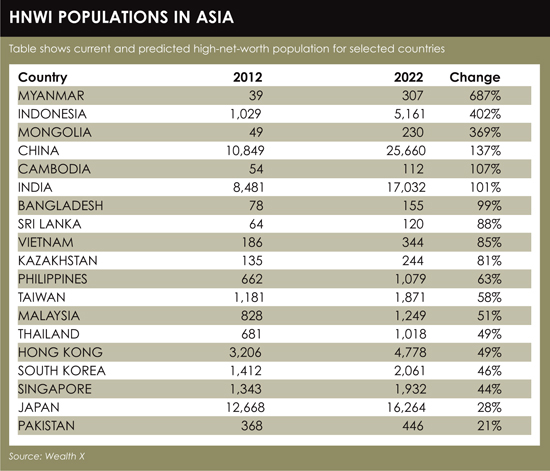 Myanmar, Indonesia and Mongolia lead the way when it comes to growth in the number of high-net-worth individuals. Oliver Knight at Frank Knight says China is still ahead in terms of sheer numbers of wealthy people.
Myanmar, Indonesia and Mongolia lead the way when it comes to growth in the number of high-net-worth individuals. Oliver Knight at Frank Knight says China is still ahead in terms of sheer numbers of wealthy people.
The global economy has provided a turbulent backdrop this year but, in spite of this, wealth continues to be created.
The amount of private wealth generated in Asia is increasing in line with the region’s rapid economic growth. We forecast that by 2022, Asia will be home to more people with net assets of at least $30 million than Europe, and will have closed the gap on North America considerably.
Myanmar, Indonesia and Mongolia lead the way when it comes to growth in the number of high-net-worth individuals – or HNWIs – with increases of 687%, 402% and 369% respectively, albeit from a relatively small base. But in terms of sheer numbers of wealthy individuals, China is ahead of the pack.
URBANISATION
Over the next decade, the number of HNWIs in China is forecast to rise by 137% to 25,660, while the number of billionaires will have increased by a staggering 214% over that time, more than double that of the US.
 This will, in part, be led by rapid population growth and urbanisation. While most countries can boast only a few large cities with more than a million residents, China has around 170, as well as five cities with populations in excess of 10 million.
This will, in part, be led by rapid population growth and urbanisation. While most countries can boast only a few large cities with more than a million residents, China has around 170, as well as five cities with populations in excess of 10 million.
By 2025, the country’s urban population is forecast to be around one billion. As cities expand, opportunities for wealth creation grow.
Forecasts for growth in the numbers of ultra-wealthy, in four so-called tier one cities – Beijing, Shanghai, Guangzhou and Shenzhen – show they will be home to more than 140 billionaires over the next decade, with a combined wealth of nearly $300 billion.
In Shanghai, the HNWI population is expected to rise by more than 160% to 3,704; more than in Washington DC, Paris or Chicago. Beijing, meanwhile, is expected to see growth of 130%.
Additionally, China’s tier two and tier three cities are also growing rapidly, and their wealthy populations are expected to expand. The total combined wealth held by HNWIs in Hangzhou, capital of Zhejiang province in eastern China, and Chengdu, capital of Sichuan province in the south-west, is forecast to be $345 billion in 2022, more than the combined wealth of HNWIs based in Zurich.
BAROMETER
The overall migration of Chinese people from rural areas into cities will mean that cities account for an even larger share of China’s economic output in the years to come. As such, it will be cities that will underpin the economic growth that will see China overtake the US as the world’s largest economy by 2030.
Turn to our Prime International Residential Index (PIRI) and a similar Asia bias can be found. The comprehensive barometer of the performance of the world’s top property markets reveals a polarised global market.
Around a third of the locations in our index showed positive price growth in 2012, but around half reported negative growth. Asia Pacific remained the main source of positive news for the luxury residential sector in 2012, with five of the year’s top ten growth markets.
DOUBLE-DIGIT GROWTH
We have commented before on the importance of the Chinese housing market to the global economy because of the huge influence the country’s construction sector has on commodity demand.
In 2012, the prime Chinese sector saw mixed results, with ongoing double-digit growth in Guangzhou and Shanghai set against lower growth in Beijing.
The Chinese capital, along with other tier one cities, has had to accommodate increasingly severe purchase restrictions. These include limits on multiple home ownership, restrictions on mortgage availability and, in some cases, a prohibition on non-resident purchases.
Despite these new controls, the weight of money chasing prime property in Shanghai and Beijing has been sufficient to ensure continued price growth in both cities throughout 2012, combined the cities accounted for 34% of China’s total HNWI population.
Oliver Knight is a research executive at Frank Knight, which produced the Frank Knight Wealth Report 2013
©2013 funds global asia

 At times like these, HSBC Asset Management easily pivots towards emerging markets.
At times like these, HSBC Asset Management easily pivots towards emerging markets. A comprehensive, cost-effective, and transparent currency overlay hedging solution is crucial to mitigate FX exposure risks in the complex landscapes of Japan and China's FX markets, explains Hans Jacob Feder, PhD, global head of FX services at MUFG Investor Services.
A comprehensive, cost-effective, and transparent currency overlay hedging solution is crucial to mitigate FX exposure risks in the complex landscapes of Japan and China's FX markets, explains Hans Jacob Feder, PhD, global head of FX services at MUFG Investor Services. The world is transitioning from an era of commodity abundance to one of undersupply. Ben Ross and Tyler Rosenlicht of Cohen & Steers believe this shift may result in significant returns for commodities and resource producers over the next decade.
The world is transitioning from an era of commodity abundance to one of undersupply. Ben Ross and Tyler Rosenlicht of Cohen & Steers believe this shift may result in significant returns for commodities and resource producers over the next decade. Ross Dilkes, fixed income portfolio manager at Wellington Management, examines the opportunities and risks for bond investors presented by the region’s decarbonisation agenda.
Ross Dilkes, fixed income portfolio manager at Wellington Management, examines the opportunities and risks for bond investors presented by the region’s decarbonisation agenda. Shareholders in Japan no longer accept below-par corporate governance standards. Changes are taking place, but there are still areas for improvement, says Tetsuro Takase at SuMi Trust.
Shareholders in Japan no longer accept below-par corporate governance standards. Changes are taking place, but there are still areas for improvement, says Tetsuro Takase at SuMi Trust. Robert St Clair, head of investment strategy at Fullerton Fund Management, explores the reasons investors should be paying attention to the rising demand for healthcare in China.
Robert St Clair, head of investment strategy at Fullerton Fund Management, explores the reasons investors should be paying attention to the rising demand for healthcare in China.


